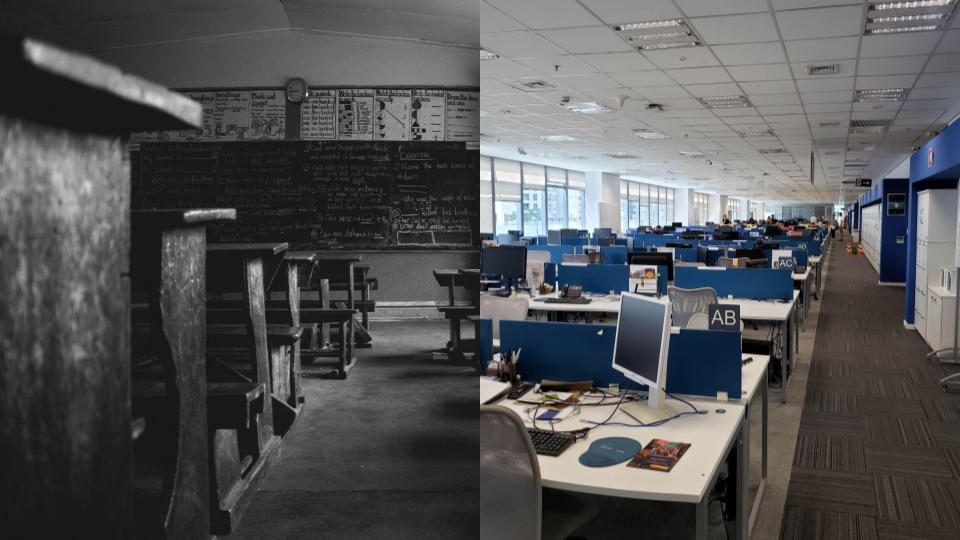Welcome to the first post in the Virtual Teams Book series. Read on or find out more about this project.
An introduction: From learning online to working online
More and more organisations are moving to working remotely. It’s becoming commonplace in sectors like education to work from home as part of geographically distributed teams. As the number of managers and leaders leading virtual teams is increasing, everyone is looking to learn how to effectively manage people and organisations once the established order of the office disappears.
For many, this change has been accelerated by the global pandemic and 2020 has been a watershed year for new ways of working. Many took part in the great shift to virtual teams as part of managing a crisis and this had many consequences that impacted unevenly on different demographics. Even once offices and campuses started to re-open many organisations and individuals took the decision to adopt new ways of working.
Many who had been working from home prior to 2020 found themselves in conversations with colleagues who were struggling to adjust to the consequences of lockdown and a global crisis whilst often working from their kitchen table, sofa or improvised desk. In the UK and elsewhere with the necessary infrastructure there was a rapid move to adopt video conferencing and online productivity tools and from there a new model of working emerged, characterised by screenshots of participants in an video call.

At the time, there was a lot of interest in finding solutions to what was for many an unforeseen situation and one for which they didn’t really have a plan. ‘Self-help’ style manuals and tips on how to manage people at a distance, how to work remotely and how to monitor and supervise employees were published widely, for example:
- How to manage an entirely virtual team CMI (2020)
- The Science Behind Managing Virtual Teams, Harvard Business Review (2020)
- Leading Virtual Teams: Managing from a Distance During the Coronavirus (2020)
In a short space of time, coping with a crisis situation was turned into an opportunity to learn how to work remotely, often with little consideration of the wider impact on employees, organisations and the communities they serve.
I will write in more depth about the consequences of this later on, as there are many interesting things to be learnt from what happened.
For now, I want to focus on one particular outcome, which is that many organisations and individuals decided that they might prefer to continue to work away from the traditional office setting and to use the pandemic as a way to achieve a big change. This change was often motivated by a range of factors, from financial savings and continued concerns about the risk of infection and serious illness to a growing recognition of the strategic and practical advantages offering more flexible working may bring.
These aren’t new insights, as there is already expertise to draw on, going back decades, including:
- Influencing Virtual Teams: 17 Tactics That Get Things Done with Your Remote Employees (2014)
- A Manager’s Guide to Virtual Teams (2012)
- Virtual Leadership: Practical Strategies for Getting the Best Out of Virtual Work and Virtual Teams (2016)
Setting aside the practicalities for the moment, the opportunity the events of 2020 presented to us was a shift in thinking. Similar to the way in which learning online became suddenly central to people’s perception of education and training, so did working from home. In a short space of time the common perception of what was possible and effective with technology for both learning and work changed completely.
And then, after this big shift in perspective, we started to think about the future, and what work (and also learning) should and could look like in the future.
Let’s skip twenty years and jump ahead
Ever since I began to work in Learning Technology nearly twenty years ago, the narrative of using technology for learning, teaching and assessment has been that this is something new, a departure from the old-fashioned classrooms kitted out with wooden benches and blackboards and chalk.
The overriding narrative has focused on the need to re-invent, modernise and otherwise revolutionise education, to make it fit for purpose, future proof and successful. This is one of the driving forces behind much of educational technology. Education in its traditional, old-fashioned model is broken, so the story goes, and EdTech can fix it.
And yet, what we know from decades of research, practice and policy making in Learning Technology is that no, it isn’t cheaper.
And yes, you still need teachers (not just machines or event intelligent machines).
Also, students and staff at all levels need continual upskilling. And no, you can’t rely solely on vendors to measure what works and what doesn’t. You need expertise to make ethical, equitable decisions that take into account the rights and needs of all involved. And no, there isn’t an AI that can do that for you. There are always risks and things go wrong frequently. Using technology for learning, teaching and assessment isn’t a nice to have anymore, it isn’t new anymore and we need to reframe the narrative of a broken education system that technology can fix, to one in which lifelong blended learning is the norm.
This may sound like an obvious point, but in my experience it really isn’t. Instead, in the past twenty years we have continued to focus on fixing education with technology. And now, technology is offering solutions to ‘fix’ the workplace. This is where lessons from Learning Technology can really teach us a lot about what’s ahead and what we can skip in order to jump right to a better new narrative.
The tools we use to work from home are very similar if not the same as those we use in education and the same problems and questions arise in both contexts: a lack of trust, collaboration and communication.
This is what the book I am working on is all about. Sharing lessons so you don’t have to discover them for yourself. In practice, I find that all the lessons we have learnt about EdTech can be translated into working as a virtual team. You need to focus on skills and support instead of savings. You need to find ways to build trust and manage crisis.

Developing your approach to leading a virtual team or organisation
Having led my team from being office based to working from home with in person elements to working entirely from home for 12+ months with no in person contact, I’ve had a lot of experience with the different options. And there is much to consider when designing your approach in a post-pandemic workplace.
After months of working remotely, we have all learned that most tasks are accomplished and most meetings go just fine without the office.
But that, the authors warn, doesn’t mean companies should suddenly abandon their workplaces. Going to the office, they argue, has never been just about work. And technology won’t make socializing less dependent on direct interpersonal contact anytime soon. In this article they describe the important social functions of an office: It’s where people build trust through personal interaction, learn the nuances of their job, and build and maintain organizational culture. And it’s through random in-person encounters between people from different functions and cultures that many of the most innovative business ideas are born. The authors conclude by showing how design, technology, and management practices can be used to make tomorrow’s offices more effective as social, learning, and innovation spaces.
https://hbr.org/2021/03/designing-the-hybrid-office
One function of in person contact is that of social interaction (outside of formal meetings) to foster relationships, social bonds and cooperation – the ‘office as a social anchor’. In person interaction, it argues, helps built commitment and support for each other and the organisation. One of the examples cited is the ‘The WELL (Whole Earth ’Lectronic Link), which started in 1985, is one of the oldest virtual communities in existence’. 35 years later, we have A LOT MORE technology and connectivity to help us establish and grow our virtual teams and communities – but what many of the teams and organisations who only moved online in 2020 don’t have, are the shared experiences of meeting up, sharing life events, supporting each other longer term.
Even in my team, having worked mostly remotely for 3-4 years now, sharing those events over time, has had a big impact already. It takes times for enough birthdays, weddings, births and so forth to happen in order to share them and for that shared experience to strengthen team and organisational culture and belonging.
In my experience the onboarding or induction process, is one of the biggest challenges of leading a virtual team.
Classically, this on-the-job learning takes place through apprenticeship. New employees learn the correct and proper way to behave—“how things are done around here”—from directly observing those around them, especially their mentors.
Technology can certainly be used to facilitate this sort of learning, but without question an office makes the process a lot easier.
Here are examples of approaches to help provide as many opportunities as possible for the kind of learning that’s described in the article.
- As a team, spend time working synchronously with a new member of staff, enabling them to observe how you use tools and systems and explore what you do day to day;
- Provide a comprehensive induction checklist, with links to processes and procedures, which you work through together;
- Start the induction process before the first day, to ensure that a new colleague knows what to expect and how to prepare, including undertaking a home-working risk assessment;
- Provide an induction focusing on the ‘why’ and bigger picture context of what the organisation does, rather than the ‘how’.
As well as onboarding new members of staff, creating informal opportunities for interaction is a big challenge. It can take a significant amount of time, effort and imagination to create time for ‘unstructured collaboration’ to happen, and initially I spent a lot of my management time experimenting with different approaches to make this happen in my team, including setting up a ‘watercooler chat’, having unstructured ‘show & tell’ elements in weekly team meetings and so forth.
Since then I’ve come to the conclusion that all of these efforts contribute something, but by far the most effective is to lead by example. Even as a senior leader, you have to make the effort to have open conversations, exploring ideas and questions, sharing thinking in progress, so that you create not only space but also time for the kind of unstructured collaboration you want to happen.
It’s an important skill for senior leaders in particular to cultivate. The result is less presentation and more collaboration – fewer meetings where no one speaks up and everyone has their cameras turned off and more days on which everyone contributes and ideas spark.
You can learn to cultivate that kind of approach to leading virtual teams, and it takes a high level of focus on your own skills in communicating and collaborating online. You need to put yourself intentionally in a position in which you would naturally be in an office – sitting at your desk with work in progress, staring out of the window whilst thinking about a difficult problem.
Head to the project page to find out more or subscribe to news about the book.
